Everyday or dressy crochet blouses for women and girls are relevant in a variety of situations. Knowing how to knit allows you not only to save on buying a finished product, but also to get clothes that are ideal in fit and size.
Yarn and patterns should be selected depending on what kind of blouse you need (summer or warm, openwork or thick, bright or casual). Despite the fact that a blouse is a garment with a fastening from top to bottom, knitted tops, pullovers and jumpers are also often called blouses.
Women's Square Pattern Sweater for Beginners
One of the most classic models remains a sweater assembled from many square motifs. In addition to knitting individual squares (which are then sewn together), you can use a special one-piece knitting pattern, which looks like individual motifs connected into a fabric.
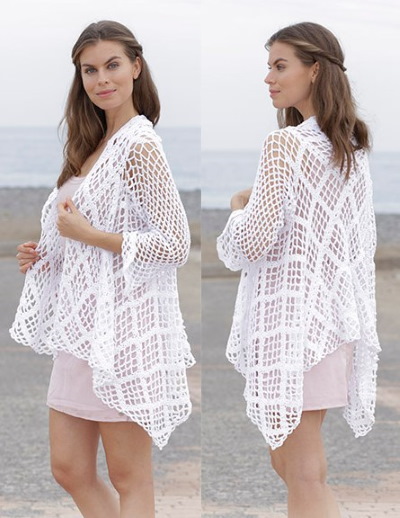
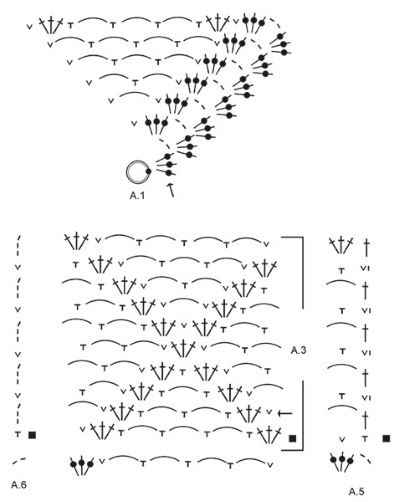
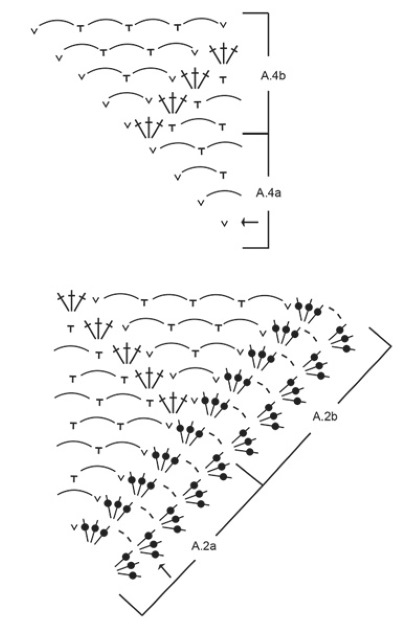
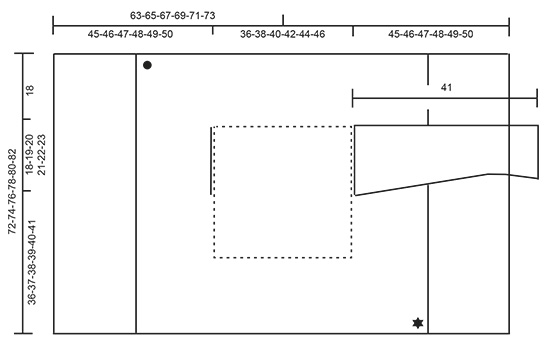
However, this is a rather complicated technique, it requires constant attention, spatial imagination, ability to concentrate and make calculations. A crochet blouse for a woman, the patterns for which are a dense or openwork square, is knitted much easier.
The entire sequence of work can be divided into stages:
- Selecting a model and yarn, taking measurements.
- Construction of a life-size pattern or creation of a technical drawing. Design of details (neck, armholes, waisting, decorative elements).
- Knitting a control sample, washing, drying, measuring.
- Calculations of the future product taking into account the knitting density.
- Working on the details of the sweater.
- Assembly (if the motifs were not connected during the knitting of the last row), final binding (if this was planned initially), wet-heat treatment, steaming or ironing of the finished product.
Beginner knitters should not complicate their work with sweaters with a clasp. Making a placket, buttonholes, and neat binding can be a serious challenge.
As the first shoulder product, it is worth considering a simple model with a rectangular silhouette (with or without sleeves). The pattern of such sweaters is 2 or 4 rectangles. It is necessary to understand that these products will have a boat neck.
If you need a round, rectangular or V-shaped neckline, the model will become more complicated. The details will no longer be simple rectangles; the sections of the fabric to the right and left of the neck will have to be formed using partial motifs. These can be rectangles or triangles (halves of the main motifs).
When modeling a knitted sweater, it is worth remembering several important points:
- The garment does not have to be exactly to the figure, it is necessary to add 5-15 cm for ease of fit. For knitting oversized items, it is necessary to add 15-30 cm to the largest volume (chest, hips or stomach).
- Crocheting requires more yarn than knitting and looks rougher. Therefore, thin and soft yarn is suitable for crocheting (cotton, viscose and silk for the summer, and wool, angora and mohair for the cold season).
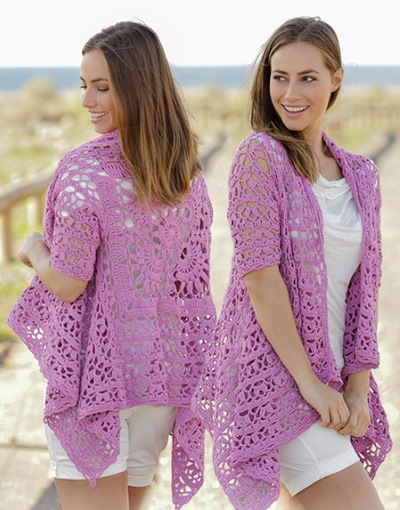


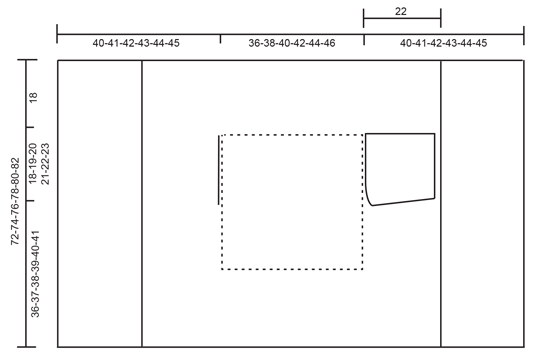
- Any knitted item looks neater and more complete if you tie its open edges with a dense binding (neckline, hemline, armholes or cuffs).
- The trend towards minimalism has remained relevant for the past few years, so you should not overload the product with decor.
To calculate the sizes of the parts, you need to take measurements (chest, waist and hips), compare them and choose the largest value. Then add the ease of fit to the selected value and divide the figure in half.
This will be the width of each piece (front and back). To find out what the length of the finished blouse will be, you can measure yourself standing up or measure another garment that fits well.
Next, you need to calculate the depth of the armhole. To do this, measure your arm at its widest point, add 5-10 cm for ease of fit, and divide this figure in half. For example, it turned out to be 18 cm. This means that when sewing side seams from the bottom up, you do not need to sew the last 18 cm. This same figure, but multiplied by 2, will be the sleeve width.
Knitting clothes from squares usually does not involve a waist or tapered sleeves, this should be taken into account when modeling.
Openwork crochet jacket
For the warm season, openwork knitted items are perfect. If they are knitted from natural yarn (they let air through, absorb moisture, and do not cause allergies), then they are not hot at all and are very comfortable.
A crochet blouse for a woman (the patterns can be absolutely anything) will look good if you wear it over a plain top or dress. Another popular option is to knit the upper part of the front and back with a solid pattern so that the underwear does not show through.
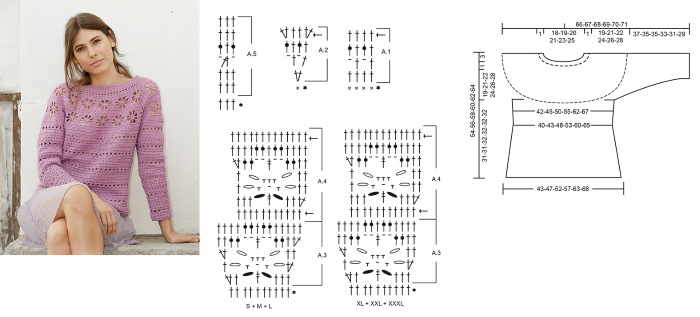
For such an insert, simple single crochets, double crochets or any dense pattern are suitable. The openwork part can look like a solid knitted lace or consist of motifs.
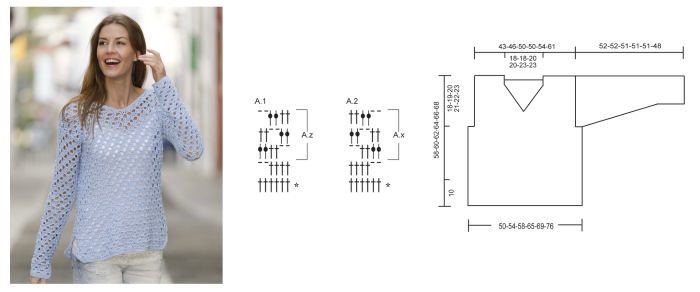
In any case, the product will have the required size and shape if you first draw a pattern of the parts in a 1:1 scale. When crocheting, the fabric is often quite dense, so it is very convenient to knit difficult areas by applying the work to the pattern (neck, armhole, waist, sleeve cap, shoulder slope).
Beginner needlewomen can be recommended to work with simpler patterns and models first, and then move on to knitting from motifs.
Summer one shoulder top
Considering that most knitted openwork sweaters and tops are designed for hot weather, they have a light structure and a loose cut. Often the neck of summer jumpers and tops is so wide that it falls on the shoulders.
In other cases, the craftswomen deliberately design the garments in such a way that one shoulder is exposed. In both cases, such clothes look attractive, they are suitable for use both in the city and on vacation.
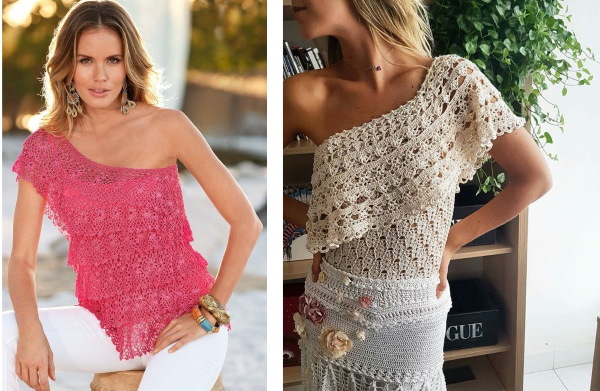
It's quite easy to get a wide neckline on a jumper - you just need to increase its length or depth. If the product is knitted from motifs, then the width of the usual neck is 25-30 cm. At the same time, there may not be any depth of the neckline if it is a “boat”.
In order for the knitted product to fall softly on one shoulder, the neck should be at least 45 cm wide. For a more obvious effect, you can also add depth - form the shoulders to the height of one motif. In fact, this will be a rectangular neck.
However, do not overdo it, otherwise the product will be impossible to wear. In the case when the neckline is still too big, it can be tied with one or more rows of single crochet stitches and tightened during the tying process.
To get a top that can't be worn in any other way than off the shoulder, you can use 2 methods:
- Knit a neat bevel on both pieces, which goes from one armhole to the second shoulder, as well as an anatomically accurate armhole.
- Knit a simple square top with one strap and decorate the edge with a voluminous flounce that will hide the insufficiently fine detailing.
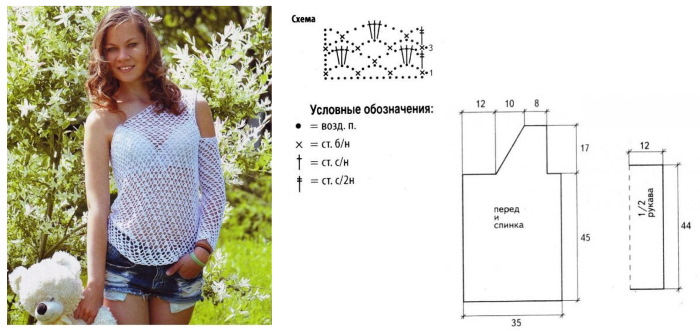
To knit a detail with complex contours, you can’t do without a pattern. You can attach any other top to thick paper, trace it and draw a bevel line. Then, when knitting, you should attach the detail to the pattern and make cuts.
In most cases, it is not possible to achieve a neat edge. As a rule, it consists of steps, so it must be tied with several rows of single crochets.
In the case of a simpler model, the top can be rectangular in shape, and a strap should be placed over one shoulder. To do this kind of work, it is not necessary to construct a pattern, correct calculations are enough.
Crochet blouses with a flounce for women can be knitted using any openwork circular pattern with an extension. This can be a piping of a circular tablecloth, the bottom of a lush knitted sun skirt or simply the final rows of a round napkin. The first row of the flounce is a row of piping, uniting the details of the front and back with a strap.
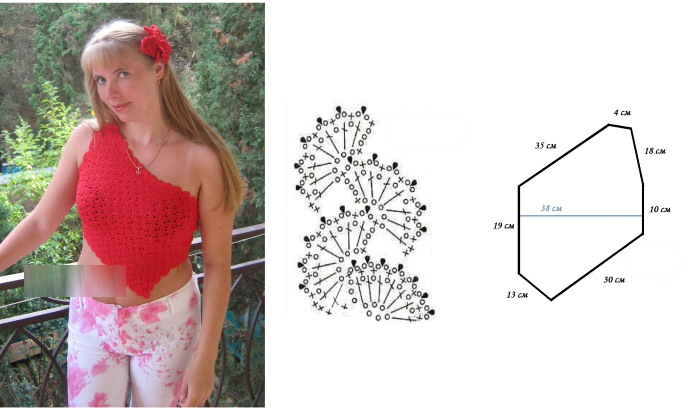
It is important that the frill is fluffy, but not excessively so, otherwise the proportions of the product will be disrupted.
Summer long sleeve sweater
If in the summer in the southern regions an open top is appropriate, then in the middle zone or in the north you will need a summer jumper, pullover or cardigan with sleeves.
If you choose a cardigan (upper body garment with a fastener), it can be done in a variety of ways:
- with a classic full-length fastening, one button or a decorative clip;
- without any fastener at all;
- any length (even short jackets to the waist);
- with long or short sleeves, sleeveless;
- openwork or dense;
- for the city, beach or home.
Simple models, the details of which are rectangles, do not require complex calculations and patterns. However, if you plan on a waist, V-shaped or round neckline, pockets, shoulder slope and anatomically correct armhole, then you cannot do without a pattern. At a minimum, you will need a detailed technical drawing with all the dimensions for work.
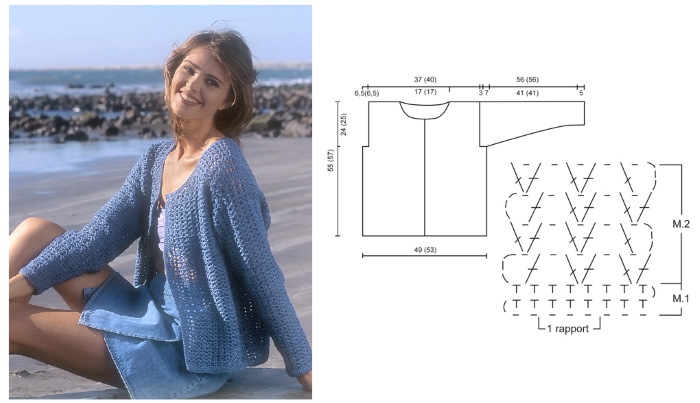
Beginner knitters may experience some difficulties with knitting the button placket. This element can be formed directly during the knitting of the fronts or knitted during the final finishing of the product.
In any case, you need to know in advance how many buttons will be sewn onto the cardigan and what diameter they will have. This determines the distance between the loops and their size.
To mark the placket, you need to divide its length in centimeters by the number of buttons. For example, if the placket is 90 cm long and there are 6 buttons, then 90/6 = 12.8 cm. This means that there will be a distance of 12.8 cm between all the buttons (5 spaces in total).
But there is still 1 gap left that should be divided in half (6.4 cm). This is the distance from the bottom edge of the placket to the first button and from the last button to the top edge of the placket. If you need to place the buttons closer to the bottom and top edges, the calculations will be different.
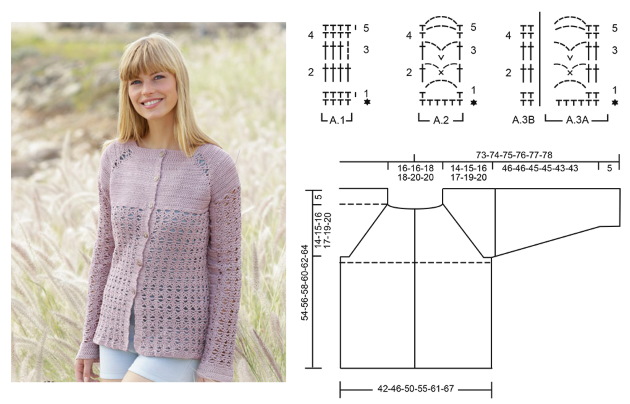
For example, 2 short intervals are planned to be 2 cm long, and the rest will be equal to each other:
- 90-2*2=86 (length of the bar without the 2 extreme gaps).
- 86/5=17.2 cm (distance between loops).
In fact, each buttonhole is an arch of a certain number of air loops (AL). For example, for a small button, you can knit a hole of 3 AL. To do this, you need to make 3 AL, skip 3 columns of the previous row and continue knitting.
In the next row, you need to knit 3 columns into the arch of these 3 VPt. Thus, the number of loops in the bar will remain the same, but a neat hole for the button will appear.
As in many other cases, when knitting a cardigan, the finishing trim is very important. It can give the entire product a finished look, decorate it or turn it into a smart item.
Crochet top with round yoke
For summer items, as well as for warmer clothes made of wool or mohair, the circular knitting method is ideal.
A crocheted blouse for a woman (the patterns can also be used for knitting children's items) with a round yoke is sometimes easier to knit than sewn models.
Here it is important to observe the size of the product (to fit it correctly on the figure) and not to mix up the rows of the pattern.
The key advantage of top-down knitting is that you can try on the garment at the initial stages. However, there are also disadvantages: such models are not very suitable for girls with large shoulders, and there is also a need to knit a sprout.
By and large, a sprout is only needed for adult items that will be used in the cold season. Summer tops, cardigans and sweaters can do without a sprout, but you should be prepared for the fact that the neckline on the back will be the same as the front.
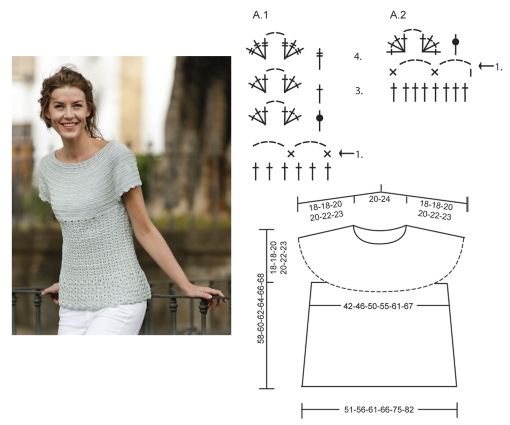
The sequence of knitting clothes with a circular yoke:
- Cast on a chain stitch for the first row.
- Knit the yoke according to the pattern, sequentially adding columns in the indicated places.
- With one circular row, join the yoke sections allocated for the front and back pieces, adding loops for undercuts on each side. Do not knit the row fragments that form the armholes.
- Knit the front and back pieces to the desired height.
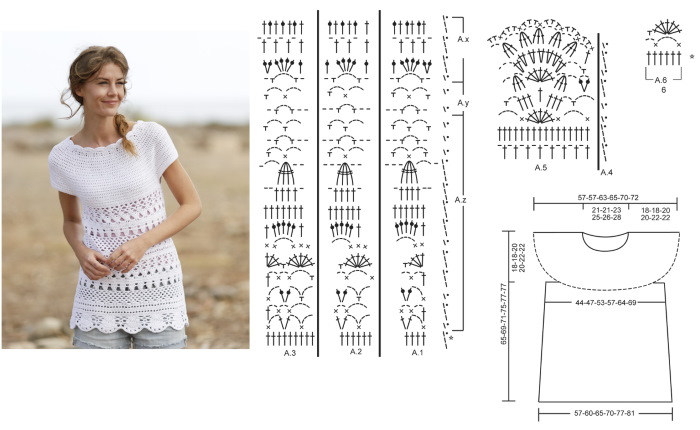 Some designers suggest additionally knitting increases on the front part (a kind of darts), but if the fabric is sufficiently elastic or very lacy, then this is not necessary.
Some designers suggest additionally knitting increases on the front part (a kind of darts), but if the fabric is sufficiently elastic or very lacy, then this is not necessary.
Crocheted clothes with an openwork yoke
In addition to the round yoke, there is also a square one. It is made in a similar way to the raglan technique in knitting: new loops are added at 4 or 8 points along the raglan lines. It is worth noting that both types of yokes can be knitted in the opposite direction (from the bottom up).
The rules for working with square yokes are the same as with round ones. This shape is perfect for adult women and children.
A crochet blouse for a woman (patterns can be very different) sometimes helps the craftswoman get rid of the remains. A circular and square yoke is knitted in long rows and allows you to immediately make a finished element of the product.
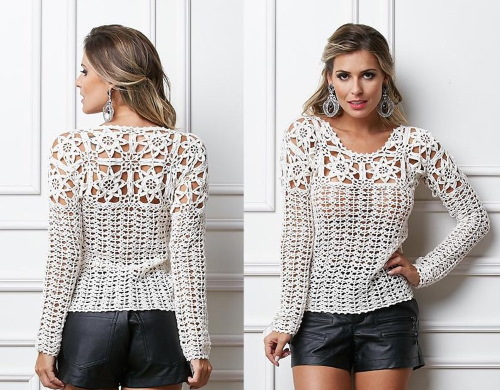
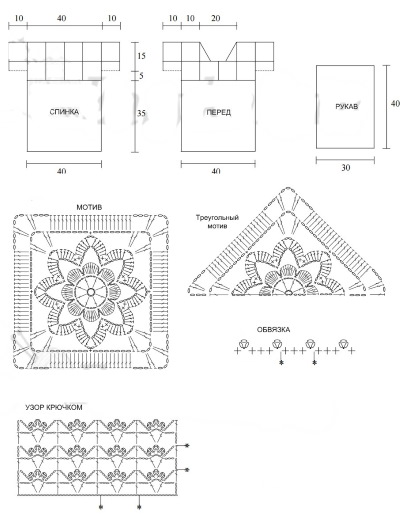
Since it is difficult to predict in advance what piece of fabric a particular yarn residue will be enough for, you can simply arrange the materials by color and thread thickness, and then knit one skein after another. You will get a striped top, jumper or blouse.
Plus size clothing models
To ensure that knitted items are truly practical and used for their intended purpose, rather than gathering dust on the far shelf of the closet, they should be thought out in advance.
There are several recommendations for those who knit large-sized clothes:
- use smooth yarn (mohair, angora and grass will visually increase the dimensions);
- focus on cuts rather than patterns;
- do not use large patterns;
- give preference to high-quality materials with good composition;
- do not knit items that are too narrow or too wide (the ideal ease allowance is 10-20 cm).

One of the best models, which looks great almost always, remains the classic cardigan. However, it should be worn without buttoning up all the way, but with a belt. In this case, the cardigan (or sweater) should be worn over plain clothes that create a vertical color.
For example, you can choose a long dress and complement it with a cardigan. A set of dark trousers, a top of the same color and a knitted sweater also looks good.
When creating large size clothing, it is worth choosing high-quality materials and natural compositions. Much has been said and written about the benefits of cotton, viscose, silk, linen, sheep and merino wool, as well as cashmere.
These materials are not only more pleasant to the touch, but also visually look respectable and noble. In addition, expensive yarn is better worn, it is easier to remove "pilling" from it, and it remains fashionable for many years (especially if the knitted model has a classic cut).
By using all these recommendations, as well as using common sense and critical thinking, you can crochet a beautiful and practical blouse for a woman or a girl using any pattern you like, even for a novice needlewoman.
Author: Anna Ocean
Article formatting:Natalie Podolskaya
Video about knitting women's blouses
Crochet blouses for women - patterns and description of a simple model:
